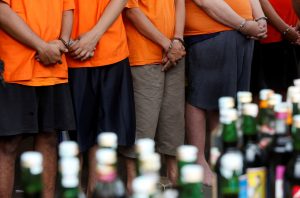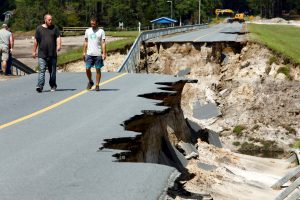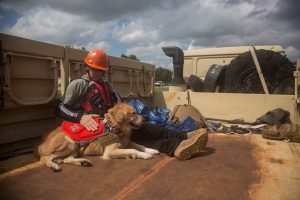
By Hyonhee Shin and Joyce Lee
SEOUL (Reuters) – North Korea’s Kim Jong Un wants a second summit with U.S. President Donald Trump soon to hasten denuclearization, but a key goal is declaring an end this year to the 1950-53 Korean War, the South’s President Moon Jae-in said on Thursday.
Moon said he and Kim spent most of a three-day summit discussing how to break an impasse and restart nuclear talks between Pyongyang and Washington, which are at odds over which should come first, denuclearization or ending the war.
Kim, who recently proposed another summit with Trump after their unprecedented June talks in Singapore, said the North was willing to “permanently dismantle” key missile facilities in the presence of outside experts, and the Yongbyon main nuclear complex, if the United States took corresponding action.
The joint statement from the summit stipulates his commitment to a “verifiable, irreversible dismantlement” of the nuclear programs, and ending the war would be a first U.S. reciprocal step, Moon said.
“Chairman Kim expressed his wish that he wanted to complete denuclearization quickly and focus on economic development,” Moon told a news conference in Seoul, shortly after returning from the summit with Kim in Pyongyang.
“He hoped a second summit with Trump would take place in the near future, in order to move the denuclearization process along quickly.”
INSPECTIONS
Moon said Kim was also open to inspection of a nuclear test site in the northwest town of Punggye-ri, which he called the North’s sole existing facility for underground detonations.
While Pyongyang has stopped nuclear and missile tests this year, it failed to keep its pledge to allow international inspections of its dismantling of the Punggye-ri site in May, stirring criticism that the move could be reversed.
U.S. Secretary of State Mike Pompeo said on Wednesday he had invited North Korea’s foreign minister to meet in New York next week and other Pyongyang officials to Vienna for talks with nuclear envoy Stephen Biegun.
Asked on Thursday if those meetings would take place, U.S. State Department spokeswoman Heather Nauert said invitations had been sent and added: “We certainly stand ready to meet if they are able to.”
Nauert said Washington looked forward to a formal readout of the North-South talks in meetings with the South Koreans next week, which will include one between Trump and Moon on Monday on the sidelines of the U.N. General Assembly.
Asked about Pompeo’s statement on Wednesday welcoming plans for the dismantlement of all facilities at Yongbyon in the presence of U.S. and IAEA inspectors, Nauert said Moon and Kim had talked about inspectors.
“Having IAEA inspectors and United States inspectors be a part of anything is really just a shared understanding,” she said.
“Any time you have a nuclear situation like this where there is a dismantlement, the expectation is that the IAEA would be part of that, so that would be just the normal course of doing business. We have that shared understanding with the countries.”
Asked why this detail was not in the document signed by Moon and Kim, Nauert replied: “We have had conversations … with the government of North Korea and that is our mutual understanding; that is also the understanding between (South) Korea and North Korea. That was one of the things discussed, according to my understanding of it, over the past few days.”
Nauert did not respond when asked if the United States was willing to take “corresponding measures,” except to say: “Nothing can happen in the absence of denuclearization; denuclearization has to come first.”
The North Korean ambassador to the United Nations, Kim Song, did not reply when asked by reporters on Thursday if his foreign minister would meet Pompeo on the sidelines of the U.N. General Assembly next week.
ENDING WAR
Kim pledged to work toward the “complete denuclearization of the Korean peninsula” during two meetings with Moon and his encounter with Trump, but follow-up negotiations on how to implement the vague commitments have since faltered.
Washington calls for concrete action, such as a full disclosure of North Korea’s nuclear and missile facilities, before satisfying Pyongyang’s key demands, including an official end to the war and the easing of international sanctions.
The war ended in an armistice, rather than a peace treaty, meaning U.S.-led United Nations forces, including South Korea, are technically still at war with the North.
But there have been concerns in South Korea and the United States that ending the war would ultimately prompt China and Russia, if not North Korea, to demand that the United Nations Command (UNC), which overlaps with U.S. forces in South Korea, be disbanded and leave.
Seoul aims to jointly announce with the United States an end to the war within this year, a measure Moon said he would discuss with Trump when they meet next week at the United Nations General Assembly in New York.
An end-of-war declaration would not affect the presence of U.S. troops and the UNC in the South, Moon said, adding that Kim shared his view.
“It would be a political declaration that would mark a starting point for peace negotiations,” Moon said.
“A peace treaty would be sealed, as well as normalization of North Korea-U.S. relations, after the North achieves complete denuclearization.”
(Reporting by Hyonhee Shin and Joyce Lee; additional repotring by David Brunnstrom in Washington and Michelle Nichols at the United Nations; editing by Soyoung Kim, Clarence Fernandez and Lisa Shumaker)













